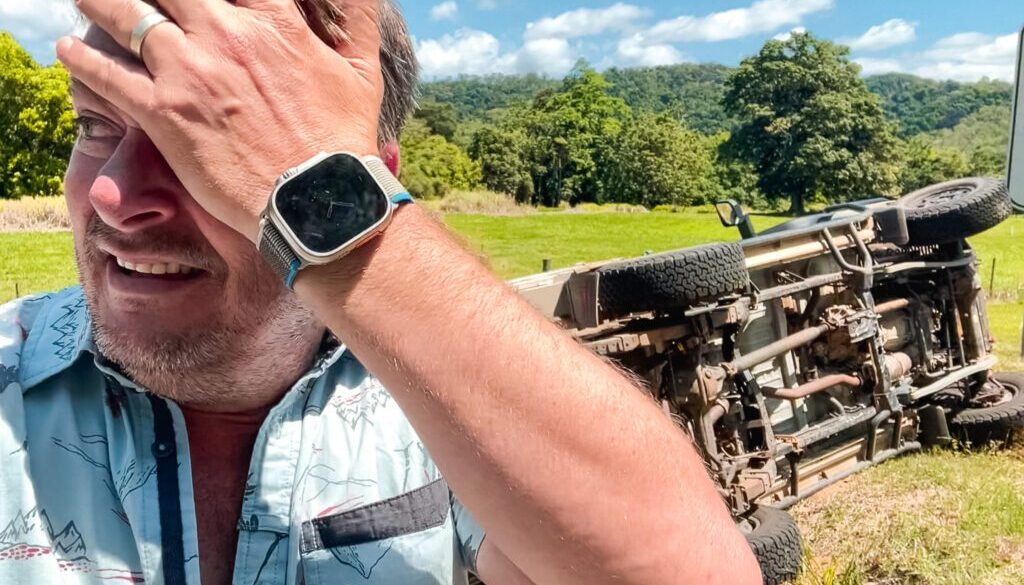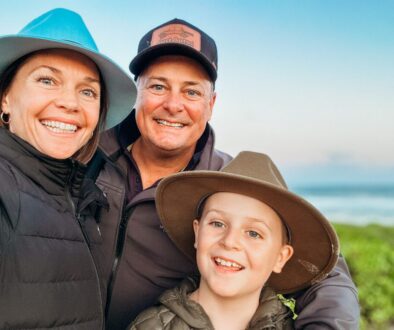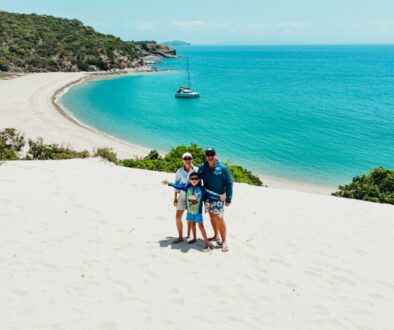How Prepared Are You? Handling Emergencies on the Road Without Panic
Road trip emergency preparedness isn’t just a checklist item, it’s one of the most important parts of safe and confident travel in Australia.
We recently found ourselves in one of those heart-racing moments every parent dreads. In remote Outback Queensland, hours from a major hospital, and Jasper suddenly needed urgent medical attention.
Thankfully, in this situation, medical help was available, and we’re so relieved to say that Jasper is doing just fine. But the experience reminded us how quickly things can change on the road… and just how important it is to have a plan in place before the unexpected happens.
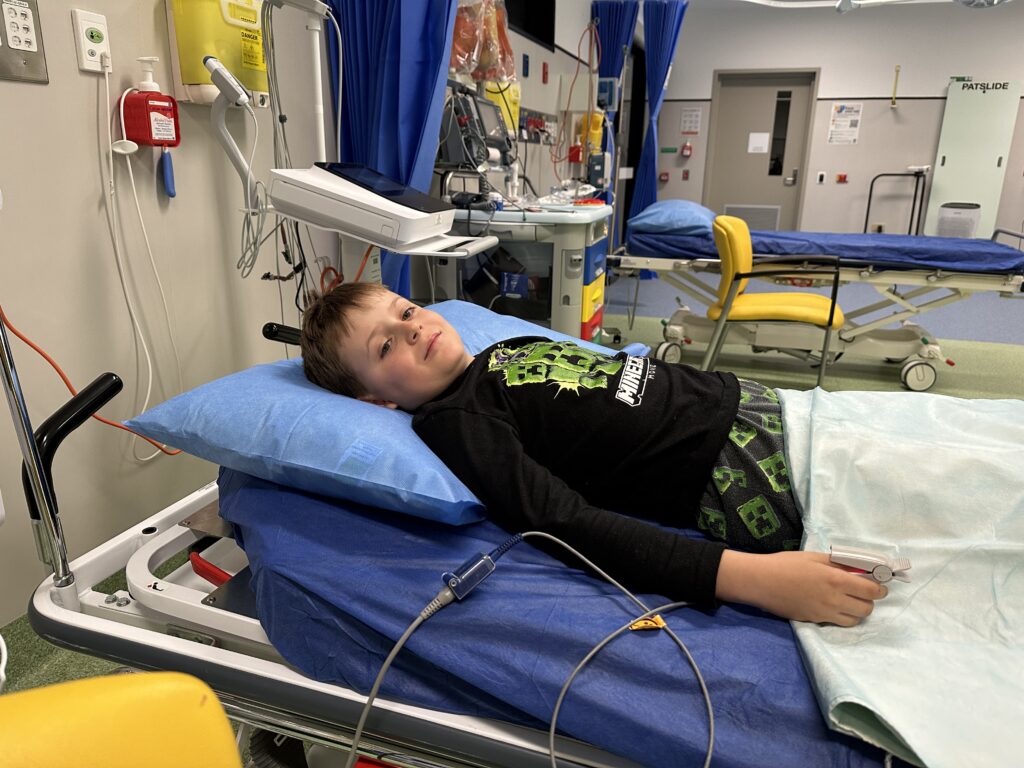
It wasn’t the first time we’ve faced an emergency on the road, and it probably won’t be the last. But what we’ve learned over six years of full-time travel is this:
You don’t need to be a survival expert to handle an emergency, you just need to be prepared.
Whether it’s a medical issue, breakdown, natural disaster, or even a run-in with wildlife, emergencies can and do happen. But with the right preparation, you can replace fear with confidence, and chaos with calm action.
This blog isn’t about scaring you off your dream trip around Australia. It’s about sharing what we’ve learned the hard way, and giving you the tools to travel safely and securely, with your head high and your heart at ease.
We’ll cover:
- What to prepare before you go
- What to do during an emergency
- How to reflect and improve after the dust settles
- The checklists, tools, and systems we personally use (and recommend to every traveller)
Because the truth is, being prepared doesn’t just protect you when things go wrong, it gives you the freedom to go further, stay longer, and truly enjoy this incredible lifestyle.
Let’s dive in.
1. Set Yourself Up Before You Leave
The best time to prepare for an emergency is long before it happens. A little effort upfront can make all the difference when you’re in the middle of nowhere with limited signal, limited time, and a whole lot of adrenaline.
Here’s how to set yourself up before you hit the road, and exactly what we recommend from our own experience:
Customise Your Emergency Contact List
Don’t rely on your memory or phone contacts in a crisis. A printed (and digital) emergency contact list should include:
- Primary medical contacts (doctor, specialists)
- Medicare details
- Emergency contacts for family or close friends
- Roadside assistance numbers
- Insurance policy numbers (car, van, personal health)
- Local emergency services for your planned route (RACQ, SES, local hospitals)
- Vet and pet insurance info (if travelling with pets)
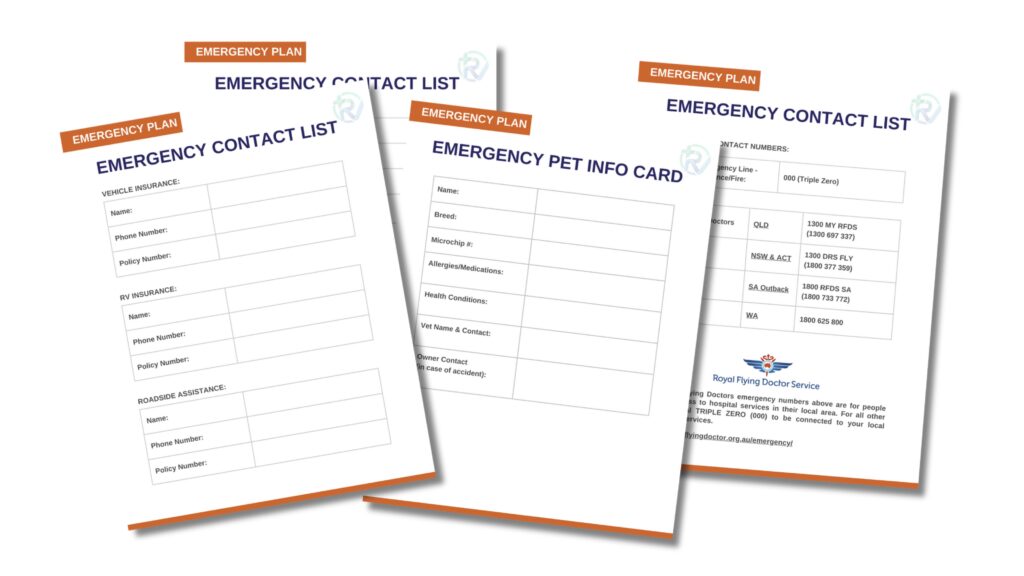
We include a printable & customisable template in our Travel Australia Guide eBook – so you’re never scrambling to remember your login or who to call.
Pro Tip: Laminate a copy and store it in your glovebox, caravan drawer, and have digital files (like Google Drive or Notes app).
Create a ‘Grab & Go’ Emergency Bag
This is a game-changer, and is often overlooked.
Your Grab & Go bag should be packed, ready, and easy to access in an emergency where you may need to:
- Get to a hospital quickly
- Leave your vehicle or van in a hurry (e.g. flood, fire, accident)
- Assist someone else who is injured or unwell
What to pack in your bag:
- A basic first aid kit (include trauma supplies – see below)
- Emergency contact list (laminated)
- Personal medications (3-5 days’ worth, rotated regularly)
- Head lamp or small torch with spare batteries
- Space blanket or thermal wrap
- Water bottle & high-energy snacks
- Power bank (fully charged) + charging cables
- Copies of ID & medical records (paper and USB)
- Hand sanitiser, gloves, face mask
- Notepad & pen (you’d be surprised how handy this is)
- Small towel or cloth
- Spare cash in small notes and coins
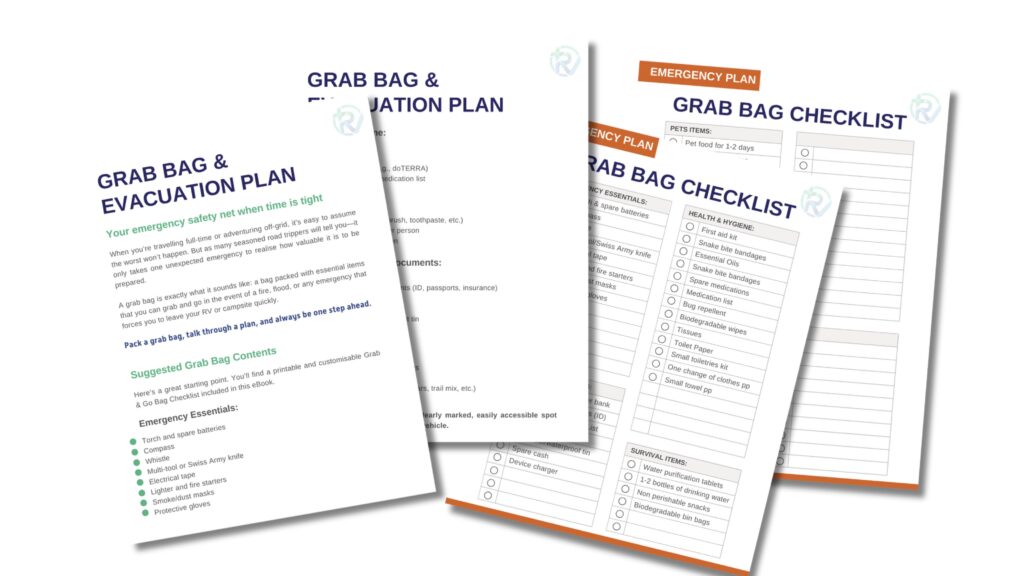
Optional add-ons: kids’ comfort item (like a small toy or dummy), essential pet supplies and medications, spare undies and socks.
Keep it in a clearly marked backpack in your vehicle or near the van door. Make it light enough to carry, but full enough to support you through the first 12-24 hours of an emergency.
Know Your Location Tools
Out in the bush, a pinned location on Google Maps just won’t cut it. Get to know these tools before you need them:
- Emergency+ App – Developed by Australia’s emergency services, it provides GPS coordinates even without mobile reception (as long as you have satellite visibility).
- What3Words – This app assigns a unique 3-word code to every 3m² square on earth. Emergency responders now use this to pinpoint locations with extreme accuracy.
- Hema Maps or ExplorOz Traveller – Ideal for off-grid navigation and location sharing in remote zones.
- UHF Radio – Your lifeline when there’s no phone reception. Know how to use it and what channels to broadcast on in an emergency.
Pro Tip: Practice reading your GPS coordinates out loud – it’ll save precious time if you ever have to call Triple Zero.
Check (and Upgrade) Your First Aid Kit
Not all first aid kits are created equal, and most “off-the-shelf” versions are either too generic or missing the essentials you’ll need on the road.
At a minimum, your travel-ready kit should include:
- Snake bite bandages (compression with indicators)
- Heavy-duty trauma shears
- Burn gel and dressings
- Saline and wound wash
- Assorted bandages, dressings, and medical tape
- Sterile gloves, alcohol swabs, tweezers
- Instant cold pack
- CPR face shield or mask
- Emergency blanket
- Splinting materials
- Pain relief (paracetamol, ibuprofen)
- Antihistamines and anti-nausea meds
- Ventolin / EpiPen if required by family members
Portable Defibrillator (AED) – Yes, It’s Worth It
Cardiac arrest can strike anyone, anywhere, even in young, fit individuals. When you’re remote, time is critical.
We recommend carrying a Cel AED – a lightweight, portable defibrillator designed for travel. It’s incredibly easy to use (with built-in voice prompts), compact, and a potentially lifesaving piece of gear.
Through RV First Aid, you can access an exclusive discount on the CEL AED – because this isn’t just a smart choice, it’s an affordable one too.
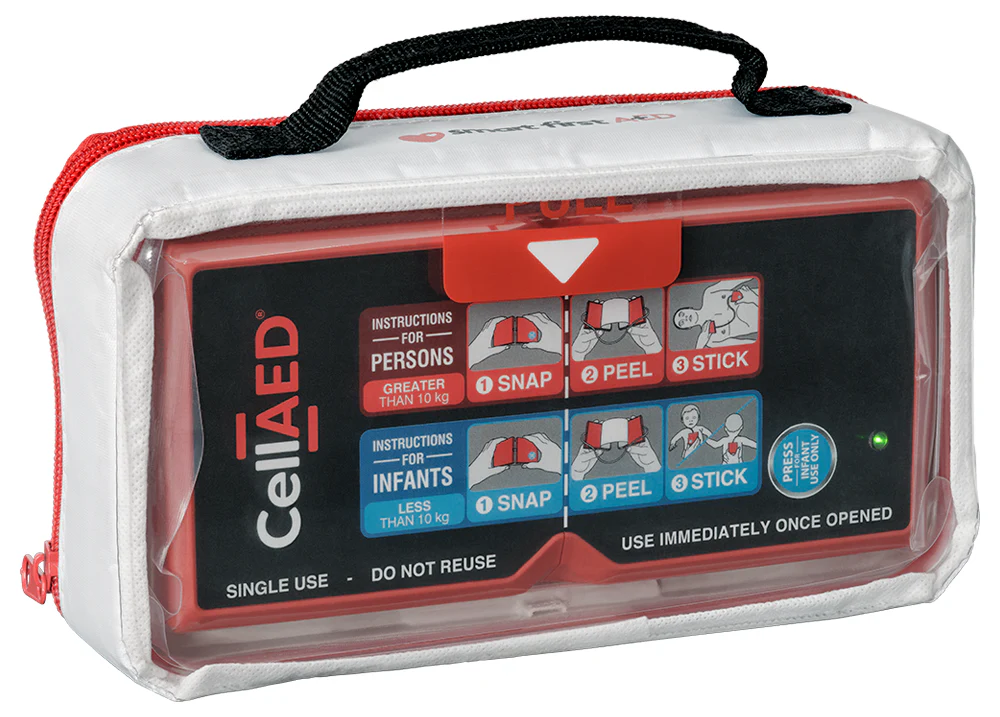
Make It a Family First Aid Kit
Here’s the thing: a first aid kit is only useful if you know how to use what’s inside, and you’re not always going to be the one holding the bandages.
Every family member, including kids, should:
✅ Know where the kit is stored
✅ Understand what’s inside and how to use key items
✅ Be capable of calling for help and giving a location
✅ Be confident to step in if someone else is injured
That’s exactly why we created RV First Aid – it’s designed to empower everyone in your travelling crew with the skills to respond confidently. The course is short, engaging, and entirely online, with bonus tips for younger travellers to follow along too.
Have a Comms Backup (Beyond Your Phone)
Your smartphone is only as good as your signal, and in large parts of rural and remote Australia, that signal can disappear without warning.
That’s why having a solid communication backup plan is essential, especially when you’re off-grid or hours from the nearest town.
Here’s what we use and recommend:
- UHF Radio – For car-to-car communication and emergency channels. We run the GME XRS system, it’s rugged, reliable, and Aussie-made. Make sure you know which channels are monitored in the region you’re travelling (e.g. Channel 5/35 for emergencies).
- GME Personal Locator Beacon (PLB) – A non-negotiable for remote travel. If you’re in a life-threatening situation, a PLB sends your GPS location to emergency services via satellite.
- Garmin inReach Mini or Zoleo – These small satellite communicators allow for two-way messaging even when you’re completely off the grid. You can share your location, send SOS alerts, or just check in with family.
- Starlink Mini (by SpaceX) – Starlink has become a game-changer for remote travellers. The new Mini version makes it even more portable. With it, you can get high-speed internet just about anywhere, allowing you to make Wi-Fi calls, use location apps, download maps, or even attend a Zoom call from the red dirt.
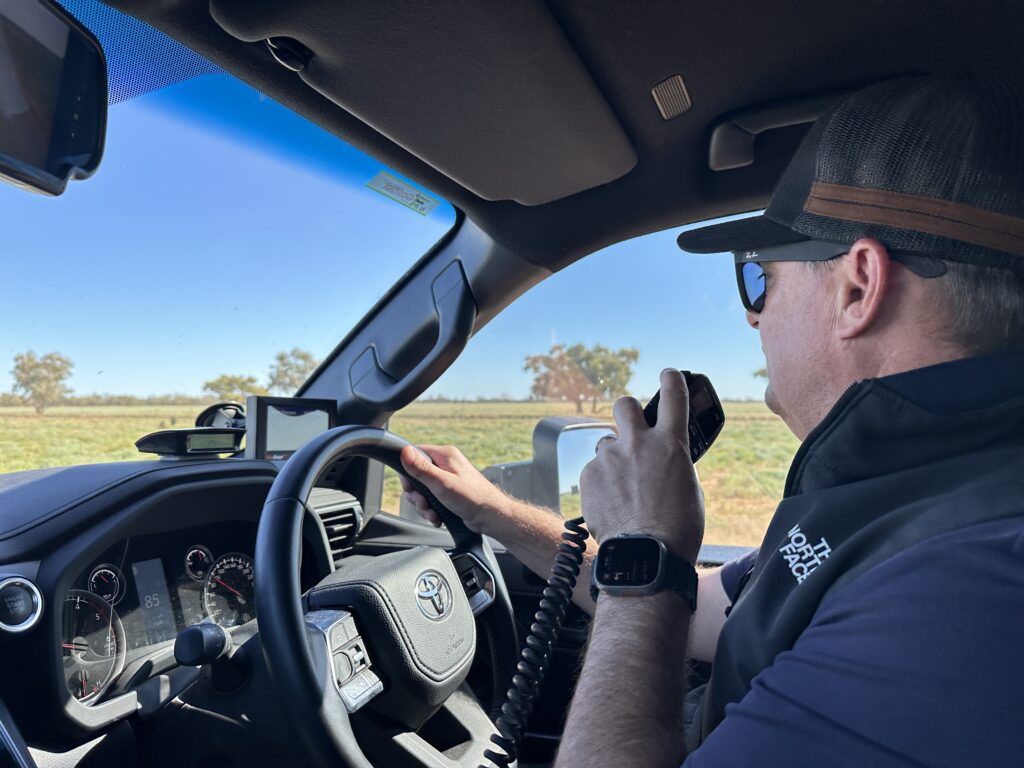
Pro Tip: Make sure everyone in your family knows how to use your backup communication devices. If only one person knows and they’re the one who gets injured or unwell, it’s a weak link in the chain..
2. What to Do During an Emergency
When something goes wrong on the road – whether it’s a medical issue, mechanical failure, or a fast-moving weather front – panic is your biggest enemy.
The key? A calm head, a simple action plan, and confidence in your systems.
We’ve experienced it all: flat tyre in the middle of nowhere, bushfire threats, a vehicle rollover, and most recently, a medical emergency with our son Jasper in remote Outback Queensland. Each time, what’s kept us steady is knowing what to do, who to call, and where everything is.
Here’s how to respond to an emergency on the road without going into meltdown mode:
Pause and Assess the Situation
Before diving into action, take a breath. Literally.
- Is the scene safe? (e.g. fire risk, traffic, environmental hazards)
- Is anyone injured or at risk?
- Is there an immediate need to call for help?
- What’s the weather doing? What time of day is it? Are you near shelter or help?
This 30-second mental checklist is crucial for prioritising and avoiding knee-jerk decisions.
Communicate Early and Clearly
If you’re unsure whether to call emergency services, call anyway. They’d rather hear from you early than after things have escalated.
Have your location tools ready (like Emergency+, What3Words, or GPS coordinates). When contacting help:
- Stay calm and speak clearly
- Provide details: who, what, where, and what help is needed
- Note who you spoke with and the time
Even if it’s not a Triple Zero call, it’s still wise to notify someone – a friend, family member, or nearby station – especially in remote areas.
Assign Roles & Use Your Gear
Every person in your setup has a part to play in an emergency. Whether you’re a family, a couple, or travelling solo, define responsibilities:
- One person calls for help
- One person handles first aid or triage (if needed)
- One person gathers gear (first aid kit, Grab & Go bag, comms devices)
- Kids are kept calm and informed, not left confused or scared
This is why we recommend familiarising your whole crew with your gear and plans before you need them.
Use Your Emergency Supplies Strategically
Now’s the time to use everything you packed “just in case.”
- First Aid Kit – From splinters to serious injuries, don’t guess – know what’s in your kit and how to use it.
- Grab & Go Bag – Whether heading to hospital, shelter, or a safer location, this pre-packed bag saves critical time.
- UHF or Satellite Comms – If mobile signal is out, switch to UHF or use devices like your Garmin inReach, Zoleo, or Starlink Mini.
- Lighting & Power – Head torches, power banks – emergencies rarely happen at a convenient hour.
For Mechanical or Vehicle-Related Emergencies
Not every crisis is a medical one. Common non-medical emergencies include:
- Major breakdowns in remote areas
- Bogging in sand or mud
- Flooded roads or bushfire alerts
- Tow vehicle or caravan incidents
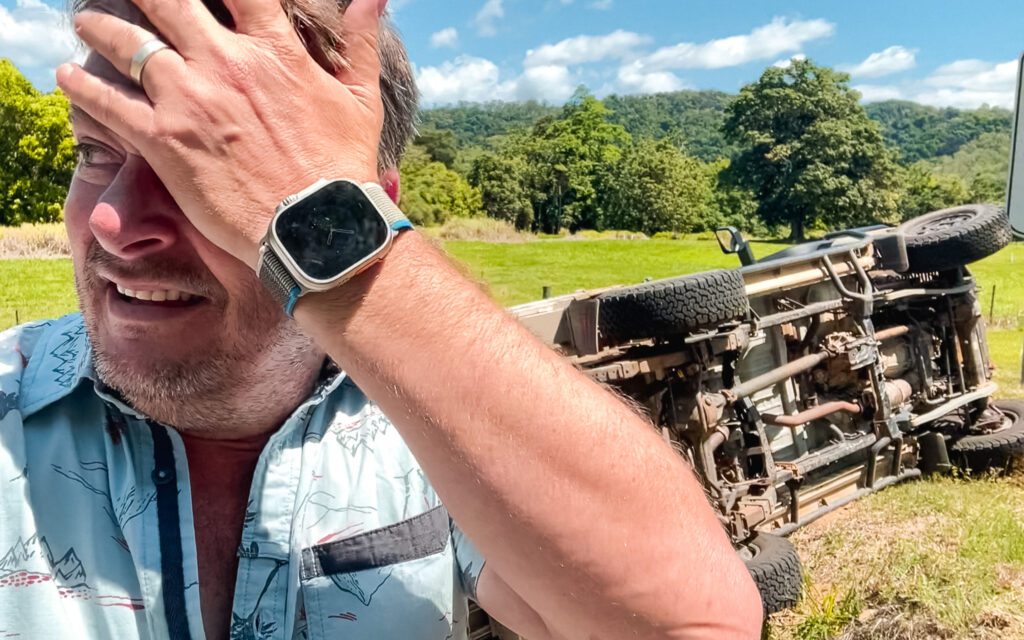
What to do:
- Make the scene safe (hazard lights, safety triangles, move clear if safe to do so)
- Use comms to contact roadside assistance, emergency services, or travellers nearby
- Deploy recovery gear if safe to do so
Stay with your vehicle until help arrives
Take Notes, Stay Grounded
During any emergency, jot down:
- Time the incident occurred
- Actions taken
- Names of people you contacted
- Any changes in condition (weather, injuries, vehicle)
This becomes incredibly helpful when briefing emergency responders, insurance claims, or just debriefing later.
The Key is Preparation, Not Perfection
No one handles emergencies perfectly, but with preparation, you can handle them well.
The more you familiarise yourself with your tools, your plans, and your roles, the more confident you’ll feel when something unexpected happens. We always say:
Preparation doesn’t ruin the adventure, it protects it.

3. Reflect and Reset
Once the dust settles – whether the emergency was big or small – it’s worth taking the time to reflect.
This isn’t about beating yourself up or playing the “what if” game. It’s about learning. Every incident, from a flat tyre to a medical scare, gives you the chance to strengthen your systems, build your confidence, and be better prepared next time.
Here’s how we do it:
Debrief as a Family or Travel Group
After an emergency, sit down and ask:
- What went well?
- What could we have done differently?
- Did we have the right gear?
- Were we confident in using it?
- Did everyone know their role?
If travelling with kids, include them in this conversation. Ask them how they felt, what they saw, and if they had any questions. It turns a scary situation into a teachable moment, and builds resilience for the future.
Restock, Replace, and Review
Check your gear and supplies after every incident:
- Use anything from the first aid kit? Restock it.
- Batteries drained? Replace or recharge them.
- Use your Grab & Go Bag? Refresh it, especially medications or snacks.
- Did a system let you down (like a flat power bank)? Update or upgrade.
This is also a great time to revisit your emergency contact list and make sure all the numbers are still current, including roadside assistance, insurance, and local health services if you’re in a new region.
Note It Down for Next Time
We like to keep a section in our travel notes (or journal) specifically for emergency learnings. Not only does this help us track what’s changed, it becomes a valuable resource we can refer back to.
You might even include a checklist like:
- First aid kit restocked
- Contacts updated
- Kids briefed
- Comms device tested
- Lesson noted
Over time, this simple habit helps you build a toolkit of real-world experience, and that’s better than any Google search when things go sideways.
Acknowledge the Win
Finally, give yourself some credit.
Emergencies are stressful. They rattle you, stretch you, and sometimes scare the heck out of you. But if you made it through, even if it was messy, that’s a win.
You kept your cool. You showed up. You learned something. That’s what matters.
Bonus Tip
If you’re part of a travelling community or online group (like a Facebook caravan page or RV community), consider sharing what happened and what you learned – not in a dramatic or oversharing way, but with the goal of helping others.
You never know who’s going to read your post and think, “Wow, I hadn’t even thought of that.”
4. Take the Next Step – Be Ready, Not Rattled
Emergencies on the road aren’t always avoidable, but panic is.
The truth is, you don’t need to know everything. You just need to do something today, that gets you and your family better prepared for tomorrow.
So whether you’re packing up for your first lap or you’ve been travelling for years, here’s what we recommend:
Get Your Systems in Place
Start with the basics:
- Create your emergency contact list
- Pack (or review) your Grab & Go Bag
- Stock your first aid kit with the right gear
- Test your communication tools
- Assign and practise family roles
For customisable templates, printable checklists, and real-world advice based on six years of full-time travel, check out our Travel Australia Guide eBook.
Learn the Skills That Could Save a Life – And Keep You Safe on the Road
You don’t need to be a doctor, but having the confidence to act in an emergency is priceless. And when you’re travelling remote, it’s not just about bandages and CPR.
RV First Aid is Australia’s most comprehensive online safety hub designed specifically for travellers. Yes, you’ll learn critical first aid skills, but it’s so much more than that.
You’ll also learn:
- Remote travel and off-grid preparedness
- 4WD recovery basics and safety
- Understanding and managing your vehicle weights (GVM, GCM, ATM, and more)
- Pet first aid – because our furry travel mates matter too
- Mental health first aid – supporting yourself and your travel companions when things get tough
- Real-world emergency scenarios tailored to travelling Australia
Built by travellers, and backed by industry experts. It’s self-paced, online, and easy to follow, with bonus tips for kids, printable checklists, and practical demos. It’s everything we wish we had when we first hit the road.
Because safety isn’t just a responsibility, it’s part of the adventure.
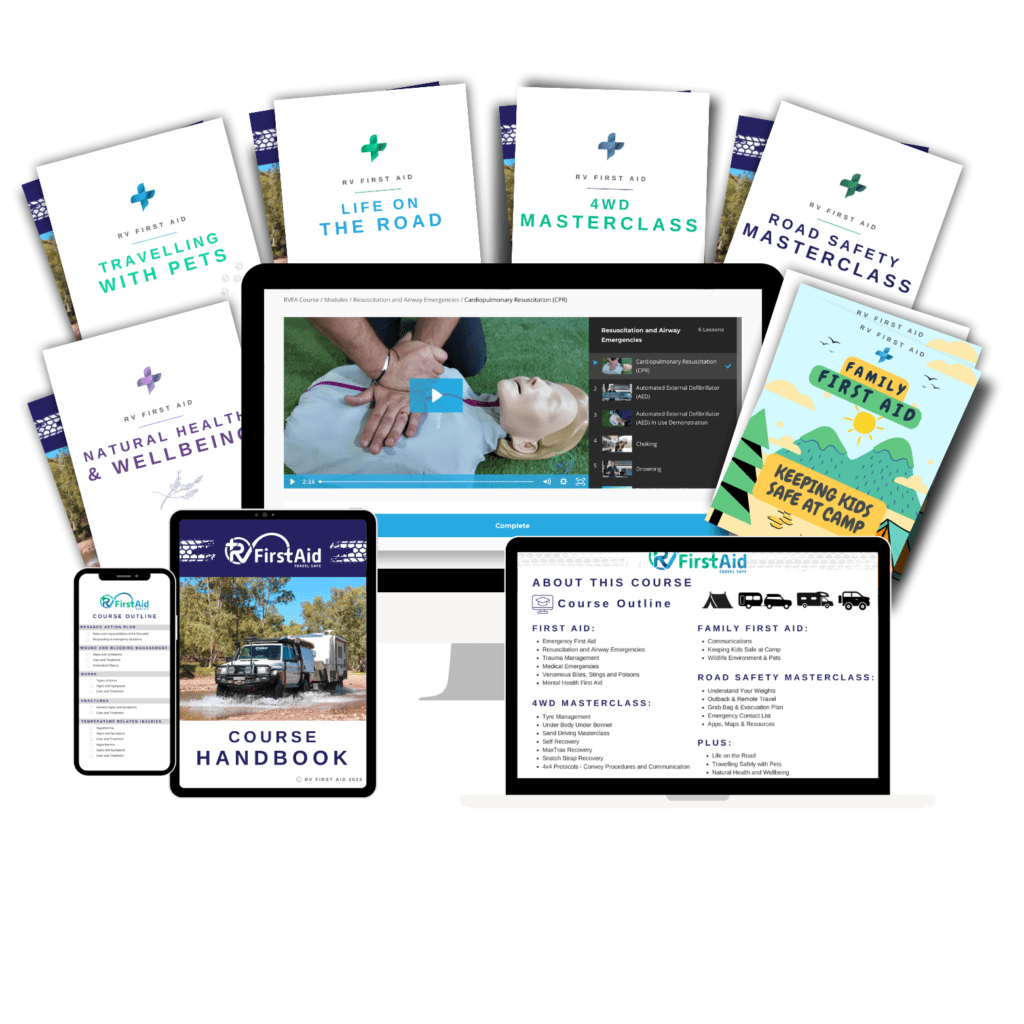
Be Safe. Stay Adventurous.
Life on the road is full of incredible moments, but also unexpected challenges.
With a little preparation, those challenges don’t have to derail your trip. They become just another story to tell around the campfire.
So here’s to safe travels, confident adventuring, and always being ready for whatever the road throws your way.

